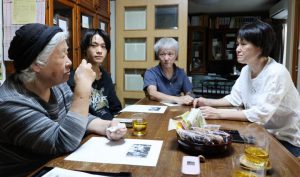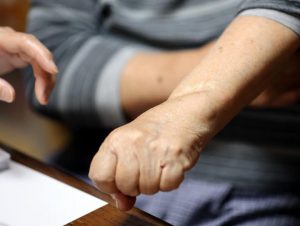Family memories 77 years after A-bombing, Part 1: Russian invasion inspired application to Family A-bomb Legacy Successors program
Jul. 27, 2022
Mother’s account of suffering must not be lost
by Taiki Yomura, Staff Writer
Yaeko Kimoto, 84, an atomic bomb survivor living in Hiroshima Prefecture’s Kure City, said, as she held out her left arm on the table at home, “A pink bone was visible. Even now my thumb doesn’t move like I want it to.” There was a distinct, pitted scarring on her wrist. Shuichiro, 20, her grandson who also lives in Kure, said, “Your thumb doesn’t move even now? I didn’t realize that,” as his facial expression clouded over.
Shuichiro and his relatives had gathered together after Yaeko’s oldest son, Seiji, 61, made the decision to become one of the Family A-bomb Legacy Successors, a new program launched by the Hiroshima City government. They sat around the dinner table and listened to Yaeko’s telling of her A-bombing experience.
Tears of recollection
At the time of the atomic bombing of Hiroshima, Yaeko was seven years old. Two months before the bombing, she had been evacuated from the Kanon area of Hiroshima (now part of the city’s Nishi Ward) to the neighborhood of Ushita-cho (now part of Higashi Ward), to be cared for by her maternal grandparents. On August 6, 1945, just after entering a temple, she felt a bright light and loud boom and became trapped under the temple’s rubble. “When I came to, I could see the sky. I struggled desperately to crawl out from under the rubble.” It was then that she injured her arm.
Yaeko’s story that day extended to the hardships suffered by her relatives and siblings. Her uncle, who was in the area of Hatchobori (now part of Hiroshima’s Naka Ward) and three of her aunts who worked at Hiroshima Teishin Hospital (located in Naka Ward) died soon after the bombing. Her grandfather cremated the bodies in a nearby park. Her two younger brothers, who had been catching cicadas on the riverbank in front of their house, suffered severe burns over their entire bodies. The older of the younger brothers dropped out of high school because he suffered keloid scars and was bullied. “I feel for all of them. I think I’m one of the lucky ones,” she said as tears trickled down her cheeks.
Yaeko also has vivid memories of a school in the village of Kuchita (now part of Hiroshima’s Asakita Ward), where she was evacuated after the bombing. A male student from Hiroshima Second Middle School (now Kanon High School) was left lying alone inside the school. She felt for him because flies were swarming around, so she chased them away with a fan. The next morning, however, he was gone. She said, “He probably died without seeing his parents.” She described corpses being piled on top of one another in the schoolyard and then cremated in fires.
Children’s cooperation
Seiji applied to the Family A-bomb Legacy Successors training program earlier this spring. While on a visit to his mother, who had lost her husband four years before and now lived alone, she began to open up about her experience little by little. It was the Russian invasion of Ukraine that inspired Seiji to communicate his mother’s experience in the atomic bombing. When Russian President Vladimir Putin hinted at the possibility of the use of nuclear weapons, Seiji thought, “The horror of nuclear weapons became more personal for me. With the decreasing number of A-bomb survivors, I don’t want my mother’s memory to be lost.”
At first, he wondered if he would be able to complete the work of writing his mother’s experience within the prescribed 25 pages, or about 10,000 kanji characters, after undergoing training during the daytime on weekdays while holding down a job at the same time. He asked for help from his younger sister, Tomoko, 59, who he described as being a good writer, and called on Shuichiro to pass on the story to young people. Seiji said he was encouraged by his family’s willingness to help.
Listening to his grandmother’s story, Shuichiro said, “This is emotional for me. The atomic bombing was truly horrifying, because people suffered not only immediately after the dropping of the bomb but also later from aftereffects and discrimination.” Tomoko, who had come to Kure City from Izumo City in Shimane Prefecture, thanked her mother for surviving. “We’re alive now. That is in and of itself a miracle.”
Seiji intends to compile Yaeko’s story into a family history that includes the experiences of her relatives who died and suffered keloid scars from the atomic bombing. He also hopes to reach out to estranged relatives to further fill out details of the history.
Anticipating the work of passing on the A-bomb experience of his grandmother to the public, Shuichiro, a third-year student at Hiroshima Shudo University in the city’s Asaminami Ward, said, “There are some things that only family can convey. I’d like to do my part, however small, for the abolition of nuclear weapons and world peace.” The history of the atomic bombing, in danger of being lost, has begun to be communicated across generations.
Keywords
Family A-bomb Legacy Successors
As a response to the aging of A-bomb survivors, the Family A-bomb Legacy Successors program was established by the Hiroshima City government in fiscal 2022 to unearth new accounts about the atomic bombing and to pass on such experiences to future generations based on cooperation from family members. After a two-year training period, children, grandchildren, and other relatives of A-bomb survivors will provide lectures to students on school trips and visitors at a number of venues including the Hiroshima Peace Memorial Museum, located in the city’s Naka Ward, on commission from the Hiroshima Peace Culture Foundation, also located in Naka Ward. A total of 54 people from Hiroshima, Yamaguchi, Fukuoka Prefecture, and Tokyo applied to the program for the first year. The program aims to get started in fiscal 2024.
(Originally published on July 27, 2022)









